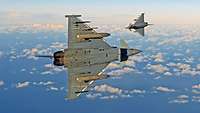
Sweden: ‘Here we do what no one else in the German Air Force does‘
Ausbildung- Datum:
- Ort:
- Schweden
- Lesedauer:
- 4 MIN
Lasers designate the target, seconds later there is an explosion on the ground. At the Swedish Test Range near Vidsel – about 100 kilometers south of the polar circle – Eurofighter and Tornado pilots practice dropping bombs, firing missiles and using the internal gun.
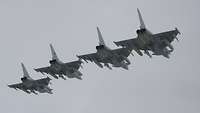
A formation of four armed EUROFIGHTERS on its way to the target area to drop precision bombs
Bundeswehr/Smoker
The maneuvers of the jets take place under operational conditions: With real weapons and live ammunition. The current tactical phase, i.e. the Live Weapons Phase (LWP) of the weapons instructor course, is all about maximum precision. Various live bombs with different capabilities are used, and tactical procedures from the previous phases of the course are verified.
For two weeks, 73 Tactical Air Wing Steinhoff and 51 Tactical Air Wing Immelmann each deployed five Eurofighter and Tornado jets, along with crews and technical support personnel, to Sweden. As a joint detachment under the leadership of the German Air Force Weapons School, they set themselves the goal of not only practicing but perfecting the use of live weapons. The cockpits are occupied by weapons instructors or those who want to become one: Participants of the weapons instructor course (WICWeapons Instructor Course) 02/21. These are selected pilots and weapon system officers who have qualified for this training due to their skills.
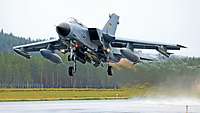
The Guided Bomb Unit 24 (GBUGuided Bomb Unit-24) weighs 1,000 kilograms and is the heaviest in the German Air Force
Bundeswehr/Petersen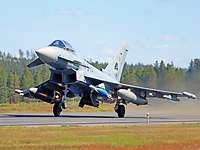
A EUROFIGHTER from Laage bearing the likeness of General Steinhoff, which the weapon school uses for training
Bundeswehr/Petersen
In addition to dropping the various (GBUGuided Bomb Unit) precision bombs, the next challenge is to engage aerial targets. For this purpose, unmanned aerial vehicles are launched in the target area, which must be intercepted and engaged. The Eurofighter pilots can detect the threat via radar or the special helmet, which is referred to as HEAHead Equipment Assembly helmet. Each individual round is fired in a highly dynamic scenario.
The IRIS-TInfra-Red Imaging System–Tail/Thrust Vector-Controlled guided missile used here has an imaging infrared seeker, enabling it to acquire and track targets. Its employment takes place under close supervision from the ground. In the Swedish control room, the unmanned aerial vehicles are controlled and all radars and optical sensors are operated in order to precisely track and document the target engagement.
The German aircraft fly into the airspace above the test range. However, the life of the remotely controlled unmanned aerial vehicles is short after they come within range of the respective shooter. ‘We acquire the unmanned aerial vehicles via our airborne radar or by means of the HEAHead Equipment Assembly helmet and engage it, although these small missiles are not so easy to see‘, is how a Eurofighter weapons instructor describes the procedure. ‘The visor of the HEAHead Equipment Assembly helmet displays weapon information, flight reference and attitude data; sensors such as the radar or the missile#enseekers can be controlled via the viewing angle.‘
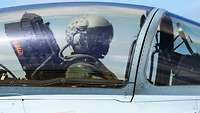
With the HEAHead Equipment Assembly (Head Equipment Assembly) helmet, Eurofighter pilots keep an eye on their flight data and what’s happening in the air
Bundeswehr/Petersen
The German Air Force’s Tornado crews, on the other hand, that are equipped with other helmets, do not have this option. They do, however, have another advantage. Unlike in the single-seat Eurofighter, they can share the tasks in their two-seat combat aircraft and thus the workload during weapon delivery. The pilot flies the jet, the weapon system officer operates the weapon system.
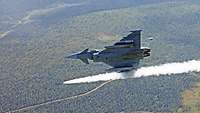
The EUROFIGHTER fires an IRIS-TInfra-Red Imaging System–Tail/Thrust Vector-Controlled guided missile at an aerial target
Bundeswehr/PetersenThe detachment is well prepared for possible technical problems: ‘If a bomb or missile should ever fail to release, the launch aircraft is parked in a specially cordoned-off area after landing‘, explains Captain Michael M. He is the officer in charge of weapons and ammunition for Tactical Air Wing Steinhoff. ‘After a certain waiting period, we then dismantle the ammunition and look for the reason of the malfunction. For all technicians, the campaign in Sweden has a special appeal‘, adds the Captain. What they like most is the direct feedback with the aircrews: ‘Knowing immediately after the mission how the mission went confirms the maintenance crews in their work and ensures enormous motivation and ultimately a strong team spirit among all detachment participants.‘
Lieutenant Colonel Dirk ‘Willi‘ Pingel is the Commandant of the German Air Force Weapons School in Laage and leads the detachment on site in Sweden. He assesses the overall value of this campaign as very high and says: ‘The use of live weapons involving almost the entire weapons portfolio of the airborne weapon systems can be practiced in this form only in the weapons instructor course and nowhere else in the German Air Force. Here, the crews learn to use the many different weapons of the aircraft in different ways so precisely that, in an emergency, only the enemy target is hit and casualties among uninvolved persons and collateral damage are avoided. Only the German Air Force Weapons School conducts such training. Above all, respect for the weapon is important – for flying personnel as well as for technical personnel.’
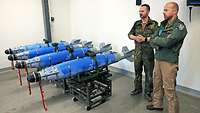
The detachment commander from the German Air Force Weapons School Laage inspects the disarmed GBUGuided Bomb Unit-54 bombs with a weapons engineer from Jagel
Bundeswehr/Petersen